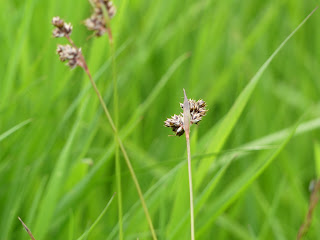It is the end of May and the survey has started. There are several ways in which you can carry out the survey, firstly, you can just simply walk and identify and enjoy the wild flowers and plants, secondly, you can take part in the 'structured walk" survey. To do this, you select one of the areas shown on the map below and walk a very large W, as you walk you stop every 5 m or so, look around you and record the plants you see, walk on another 5 m and do the same until you have completed 10 points making up the W. If you wish to do this part of the survey there is a specially constructed sheet to record on and it can be forwarded to you on request. It is this data which would enable us to properly assess the quality of the grassland. Below you will see a gridded map on which I have outlined the survey areas, these are based on what I already know and in particular the type of soils which are very variable on the Park.
The second is the Pignut. It is not a very tall plant and can get confused with Cow Parsley. The Pignut is shown first along with a close-up of the flower head. A magnifying glass or hand lens would be a very useful acquisition to take a close look at the magnified beauty of plants.
And now the Cow Parsley.
Note the coarser, fernlike leaves and the asymmetrical flowerheads.
Next is a relative of the Dock which is the Common Sorrel. Once again, it has surprisingly beautiful and very much overlooked flowers.
One of the indicators of very old grassland is the Field Woodrush. This has now been on flower for some weeks and the photograph shows the brown 'nutlet seeds'. Because it came on flower earlier it is now been overtaken by other plants and will need to be searched for carefully.
A beautiful little blue flower growing low down is the Common Speedwell.
Cowslips have now set seedheads but look carefully for the clumps of leaves because they will gradually die down as the season and advances.
We can expect to see both red and white Clover as the season moves on but at the moment it is just the Red Clover on bloom.
The next to flower is one of the Cranesbill family, so-called because of the shape of the seed head. They are difficult to pin down to an exact identification.
At the moment, the Yarrow can only be found in the form of its fernlike leaves that we can find the white flower later on.
This is the Hoary or Ribwort Plantain.
Now it starts to get a bit more difficult with the grasses. The first one is the Soft Brome.
Next is the Meadow Foxtail grass.
And finally, in this first post, we shall be looking for what we call Negative Indicators. All the ones that have gone before are Positive Indicators because they are showing that the grassland is in good health. Negative Indicators show that the grassland could be deteriorating and one of the first ones of these to keep a look out for and record is the Creeping Thistle. It is actually a good nectar source for butterflies but can start to take over the grass sward.



























No comments:
Post a Comment